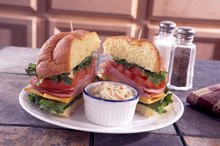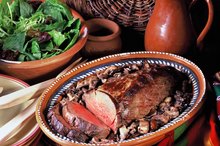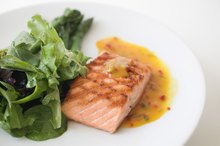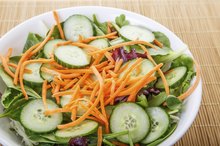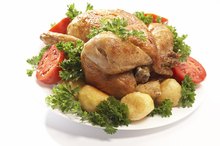What does fact checked mean?
At Healthfully, we strive to deliver objective content that is accurate and up-to-date. Our team periodically reviews articles in order to ensure content quality. The sources cited below consist of evidence from peer-reviewed journals, prominent medical organizations, academic associations, and government data.
The information contained on this site is for informational purposes only, and should not be used as a substitute for the advice of a professional health care provider. Please check with the appropriate physician regarding health questions and concerns. Although we strive to deliver accurate and up-to-date information, no guarantee to that effect is made.
Do Frozen Dinners Have Too Much Sodium?
The convenience and relatively low cost of frozen dinners makes them a tempting choice whether you are pressed for time or unable to cook a meal from scratch. However, some frozen dinners contain more sodium than you should consume in one meal or even in one day. Before you microwave or warm up your next frozen meal, analyze the sodium content to determine whether the particular frozen meal is a healthy choice for you.
Sodium Recommendations
The U.S. Department of Health and Human Services established sodium recommendations in its “Dietary Guidelines for Americans.” The guidelines state that your sodium levels should remain under 1,500 mg per day if you are black, over the age of 51, have coronary heart disease, kidney disease or high blood pressure, or if your doctor recommends it 1. If you meet none of those conditions, your maximum sodium intake should be 2,300 mg per day. A frozen dinner that has 900 mg of sodium comprises more than half of the 1,500 mg recommendation and almost 40 percent of the 2,300 mg recommendation.
Dangers of High Sodium Intake
The Sodium Content of Lunch Meat
Learn More
The relatively high sodium content in many frozen dinners occurs because manufacturers use sodium to enhance the flavor of the frozen food and as a preservative, according to registered dietitian Katherine Zeratsky of the Mayo Clinic. When you consume sodium through the food you eat, the sodium in your blood increases, which in turn causes more fluid to enter your blood vessels and eventually increases your blood volume. This increase in blood volume raises your blood pressure. The Centers for Disease Control and Prevention indicates that suffers of high blood pressure are at increased risk for both heart disease and strokes.
- The relatively high sodium content in many frozen dinners occurs because manufacturers use sodium to enhance the flavor of the frozen food and as a preservative, according to registered dietitian Katherine Zeratsky of the Mayo Clinic.
- When you consume sodium through the food you eat, the sodium in your blood increases, which in turn causes more fluid to enter your blood vessels and eventually increases your blood volume.
Sodium Levels
The sodium content in frozen dinners varies depending on the meal. A serving of frozen lasagna with meat contains 832 mg of sodium, and a serving of turkey pot pie has 1,390 mg of sodium, according to the USDA Nutrient Data Laboratory 2. Even diet frozen meals can be high in sodium. An example is a chicken and almond entree, which has only 250 calories, but 490 mg of sodium. Other diet meals have higher amounts of sodium, with a sesame chicken entree containing 650 mg, and a diet rigatoni with meatball dinner having 830 mg. The lower the sodium content in your frozen dinner, the better it is for you. Eating less than 500 mg of sodium for dinner leaves you enough leeway to have foods with average amounts of sodium for other meals and snacks.
- The sodium content in frozen dinners varies depending on the meal.
- Other diet meals have higher amounts of sodium, with a sesame chicken entree containing 650 mg, and a diet rigatoni with meatball dinner having 830 mg.
Strategies
Pot Roast Nutrition
Learn More
Examine both the calories, nutrients and sodium content of any frozen foods before you purchase them. If you are dieting or monitoring your fat consumption, look for frozen meals with lower amounts of overall and saturated fat as well as lower sodium contents. An alternative to commercially frozen meals is to create your own frozen meals at home. Make hamburgers with extra-lean ground beef and freeze the patties in separate containers. Warm the hamburger, and serve with a serving of canned fruit, a whole-wheat hamburger bun and 1 cup of frozen, heated vegetables. You can make a low-fat chicken, rice and broccoli casserole and freeze in individual servings. Add fruit and a bun for a complete dinner.
- Examine both the calories, nutrients and sodium content of any frozen foods before you purchase them.
- Make hamburgers with extra-lean ground beef and freeze the patties in separate containers.
Related Articles
References
- U.S. Department of Health and Human Services: Dietary Guidelines for Americans 2010
- USDA Nutrient Data Laboratory: Lasagna with Meat & Sauce, Frozen Entree and Turkey Pot Pie, Frozen Entree
- North Dakota State University; Prairie Fare: Freeze Meals Now, Save Time Later; Julie Garden-Robinson, LRD
- American Heart Association. Sources of Sodium.
- Centers for Disease Control and Prevention. Top 10 Sources of Sodium. 2017.
- Institute of Medicine. Dietary Reference Intakes Tables and Application. National Academies of Sciences, Engineering, and Medicine, Health and Medicine Division. 2015.
- United States Department of Agriculture. Dietary Guidelines for Americans 2015–2020. United States Department of Health and Human Services. 2015.
Writer Bio
Diane Lynn began writing in 1998 as a guest columnist for the "Tallahassee Democrat." After losing 158 pounds, she wrote her own weight-loss curriculum and now teaches classes on diet and fitness. Lynn also writes for The Oz Blog and her own blog, Fit to the Finish. She has a Bachelor of Science in finance from Florida State University.
